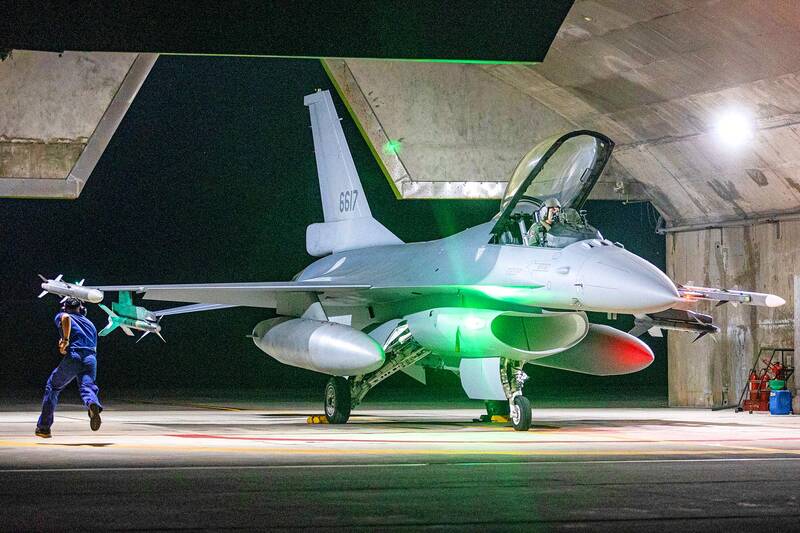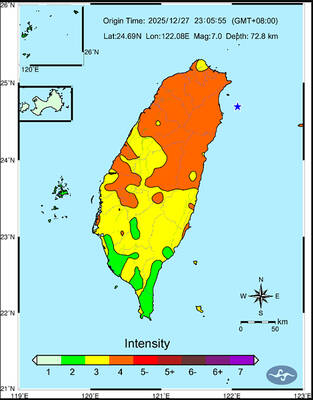The Executive Yuan yesterday proposed NT$415.1 billion (US$13.75 billion) in defense spending for next year, a double-digit increase from this year that includes funds for new fighter jets, weeks after China staged large-scale military exercises around the nation.
China carried out its largest-ever war games around Taiwan after a visit this month by US House of Representatives Speaker Nancy Pelosi.
The overall defense budget proposed by the Cabinet would increase 13.9 percent year-on-year to a record NT$586.3 billion.

Photo: CNA
That includes an additional NT$108.3 billion for fighter jets and other equipment, as well as “special funds” for the defense ministry.
The Directorate-General of Budget, Accounting and Statistics (DGBAS) did not provide a specific breakdown of where the money would go.
The planned defense spending, which is a record high and must be approved by the Legislative Yuan, marks the nation’s sixth consecutive year of growth in defense spending since 2017.
The double-digit rise this year marks a sharp increase compared with its annual growth rate of below 4 percent since 2017.
DGBAS Minister Chu Tzer-ming (朱澤民) said the increase would mainly go to operational costs.
“We always give safety and national security the top priority ... that’s why [the budget for] operational costs has sharply increased,” Chu said, pointing to costs such as fuel and maintenance for aircraft and ships dispatched to counter Chinese military activity near Taiwan.
The Ministry of National Defense (MND) said in a statement that the budget gave full consideration to the “enemy threat” and was equivalent to 2.4 percent of Taiwan’s projected GDP for next year.
“In the face of the Chinese communists’ continuous expansion of targeted military activities in recent years and the normalized use of warships and military aircraft to raid and disturb Taiwan’s surrounding seas and airspace, the military adheres to the principle of preparing for war without seeking war and defending national security with strength,” it said.
Excluding the extra budget for military equipment and funds, the proposed defense spending represents a 12.9 percent year-on-year increase, compared with a 20.8 percent increase in the overall government budget proposed for next year.
The proposed spending would account for 14.6 percent of the government’s total expenditure for next year and is the fourth-largest segment, after social welfare, combined spending on education, science and culture, and economic development.
Taiwan last year announced an extra defense budget of US$8.69 billion by 2026, which comes on top of its yearly military spending, mostly on naval weapons, including missiles and warships.
China has continued its military activities near Taiwan, though on a reduced scale. On Wednesday it announced that live-fire drills would take place in a coastal part of China’s Fujian Province today and on Saturday, just north of the tiny Taiwan-controlled Wuchiu Island (烏坵) in the Taiwan Strait.
Institute for National Defense and Security Research analyst Su Tzu-yun (蘇紫雲) yesterday said that the MND had included special funds in its calculations of the country’s defense spending in relation to GDP, which is not the typical way such figures are derived.
The government should prioritize defense spending over other considerations in light of the clear and present danger facing the nation, he added.
Countries that face significant external threats to national security — such as Israel and South Korea — typically spend between 2.8 percent and 3.2 percent of their GDP on defense, which shows that Taiwan’s military budget has room for growth, he said.
Specifically, the MND should increase military spending to about NT$480 billion per year and set its sights on eventually using 3 percent of GDP for national defense annually, he said.
“The value of time should be factored into discussions about budget costs,” he said. “If the military does not receive funding when it is needed, we can end up paying more for the lost time.”
Additional reporting by Aaron Tu

A magnitude 7.0 earthquake struck off Yilan at 11:05pm yesterday, the Central Weather Administration (CWA) said. The epicenter was located at sea, about 32.3km east of Yilan County Hall, at a depth of 72.8km, CWA data showed There were no immediate reports of damage. The intensity of the quake, which gauges the actual effect of a seismic event, measured 4 in Yilan County area on Taiwan’s seven-tier intensity scale, the data showed. It measured 4 in other parts of eastern, northern and central Taiwan as well as Tainan, and 3 in Kaohsiung and Pingtung County, and 2 in Lienchiang and Penghu counties and 1

FOREIGN INTERFERENCE: Beijing would likely intensify public opinion warfare in next year’s local elections to prevent Lai from getting re-elected, the ‘Yomiuri Shimbun’ said Internal documents from a Chinese artificial intelligence (AI) company indicated that China has been using the technology to intervene in foreign elections, including propaganda targeting Taiwan’s local elections next year and presidential elections in 2028, a Japanese newspaper reported yesterday. The Institute of National Security of Vanderbilt University obtained nearly 400 pages of documents from GoLaxy, a company with ties to the Chinese government, and found evidence that it had apparently deployed sophisticated, AI-driven propaganda campaigns in Hong Kong and Taiwan to shape public opinion, the Yomiuri Shimbun reported. GoLaxy provides insights, situation analysis and public opinion-shaping technology by conducting network surveillance

‘POLITICAL GAME’: DPP lawmakers said the motion would not meet the legislative threshold needed, and accused the KMT and the TPP of trivializing the Constitution The Legislative Yuan yesterday approved a motion to initiate impeachment proceedings against President William Lai (賴清德), saying he had undermined Taiwan’s constitutional order and democracy. The motion was approved 61-50 by lawmakers from the main opposition Chinese Nationalist Party (KMT) and the smaller Taiwan People’s Party (TPP), who together hold a legislative majority. Under the motion, a roll call vote for impeachment would be held on May 19 next year, after various hearings are held and Lai is given the chance to defend himself. The move came after Lai on Monday last week did not promulgate an amendment passed by the legislature that

AFTERMATH: The Taipei City Government said it received 39 minor incident reports including gas leaks, water leaks and outages, and a damaged traffic signal A magnitude 7.0 earthquake struck off Taiwan’s northeastern coast late on Saturday, producing only two major aftershocks as of yesterday noon, the Central Weather Administration (CWA) said. The limited aftershocks contrast with last year’s major earthquake in Hualien County, as Saturday’s earthquake occurred at a greater depth in a subduction zone. Saturday’s earthquake struck at 11:05pm, with its hypocenter about 32.3km east of Yilan County Hall, at a depth of 72.8km. Shaking was felt in 17 administrative regions north of Tainan and in eastern Taiwan, reaching intensity level 4 on Taiwan’s seven-tier seismic scale, the CWA said. In Hualien, the